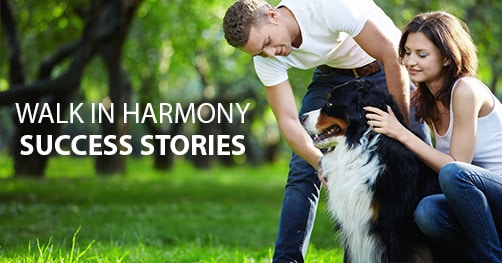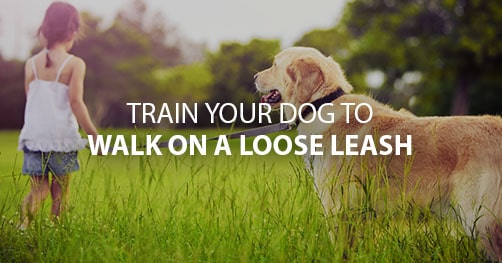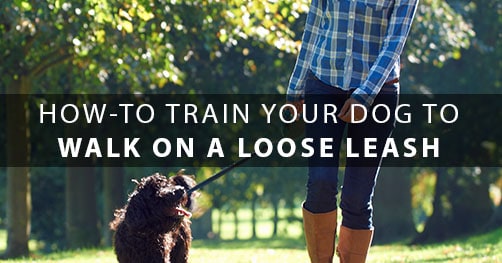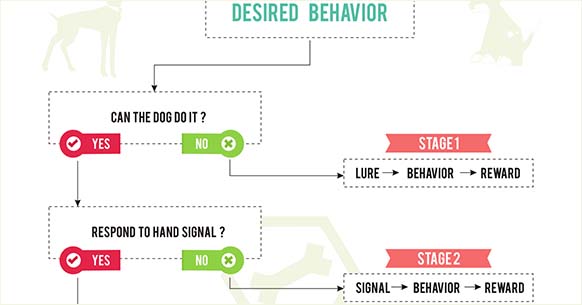Success Stories: How Our Students Are Training Their Dog To Walk On A Loose Leash (And Stop Pulling On The Leash)
In my first article in this series on training your dog to walk on a loose leash without pulling, I shared my unique four-step training process. In my second article I discussed the five most important reasons you should train your dog to walk on a loose leash.
In this article I will share some of my students’ success stories. You’ll see that it’s possible to transform your dog’s walking behavior, no matter your circumstances. And by the end of the article you’ll be motivated to take action yourself. If others can do it, so can you.
I would like you to meet two dogs, Balto and Makita, belonging to one of my students.

Balto and Makita are large dogs that weigh over one hundred pounds each. Their owner, Luann, was having a difficult time walking them together because they were easily distracted. But with the help of the self-control training games inside my Walk In Harmony Game Plan, Luann was able to teach her dogs to focus on her.
Here is what Luann said after completing my program:
[order_box style=”4″ alignment=”center”]“Because of the Walk in Harmony Game Plan, I can finally walk both of my dogs at the same time and go to parks, beaches and even hiking with them. I have a 3 year old small Siberian Husky and 7 month old 100 pound Alaskan Malamute and they both are natural pullers when walking on a leash. I had to take them on walks separately because of the pulling and being distracted so I only took them one at a time up and down my block. After using this program on both dogs I can now take them on walks together and go to parks and beaches, hiking and anywhere I want.
This program is a fun-filled positive, motivating, and bonding program for both owner and their dog. The Walk In Harmony Game Plan is user friendly, day by day steps which makes it easy to understand, and very precise easy to follow videos.”
[/order_box]Building your dog’s self-control is vital. It will teach your dog to think twice before running after something like a squirrel or another dog. And the best thing is that you can start building your dog’s self-control in only five minutes and in the comfort of your own home.
For example, my popcorn training game teaches your dog to ignore a pile of popcorn on the ground. Although you’re not likely to see this while walking your dog, the purpose of the training game is to build your dog’s tolerance for distractions by focusing on you instead of the distraction. The game serves as a blueprint you can use to train your dog to overcome any distractions including a dog barking, a squirrel running, or something on the ground.
If you haven’t yet tried my popcorn training game, here is a sample video showing exactly what to do:
Meet another student who has gone through my Walk In Harmony Game Plan: Lisa also struggled because her dog Doodle was easily distracted. But her dog reacted differently than Luann’s. Instead of just pulling on the leash, Lisa’s dog would also become overly excited and bark uncontrollably at the distractions. Lisa found herself in a quandary: How could she get her dog to stop barking?
Like Luann, Lisa also found the self-control training games to be extremely beneficial. Here is what she wrote to me after completing the program:
[order_box style=”4″ alignment=”center”]“My dog is a 9 month old Doodle who was very easily distracted by birds, cats, other dogs and especially squirrels. The walk was a constant struggle because he would zone out at the sight of any of these. He would become extremely excited, pulling and barking and then remain in that state of excitement for the rest of the walk. We had an AHA moment where I understood how to apply the ‘ It your choice’ principal to the beginning of the walk.”
“Some days we don’t walk at all we just practice going back and forth up the driveway working on self-control and paying attention to me. This has greatly improved our walk. He is much better when passing dogs now. He still gets really excited with squirrels but he seems to recover from them a little quicker so that I get his attention back. He is still a work in progress and we have a ways to go yet but I feel more confident now with the tools I learned from Jean’s program. I have always used positive reinforcement when training Doby but the addition of the ‘it’s your choice’ component has made a huge difference.”
[/order_box]If you’re wondering what Lisa means by “It’s Your Choice,” it’s the process of teaching your dog that it has a choice. Instead of punishing your dog for bad behaviors like pulling on the leash or barking, I teach my students to offer their dogs a choice. If their dog makes the right choice, such as paying attention to them, walking next to them, or ignoring distractions, then they reward it.
This is the opposite of what many traditional dog trainers teach. Many dog trainers will have you punish your dog for bad behaviors by either pulling sharply on the leash or using a pain-inflicting device like a choke or prong collar.
There’s none of that in my program. Instead, my program requires you to think creatively and to understand what goes on in your dog’s mind. As you offer your dog choices, your dog will learn to think about what it’s doing, and over time your dog will learn to look for ways to please you, even when you’re not actively asking it to do anything.
That is how I teach my students to train their dogs, and that ultimately leads to the happy, well-behaved family dog they’re proud of.
Now I’d like you to meet Chester, another dog that has gone through my Walk In Harmony Game Plan with her owner Marianne.
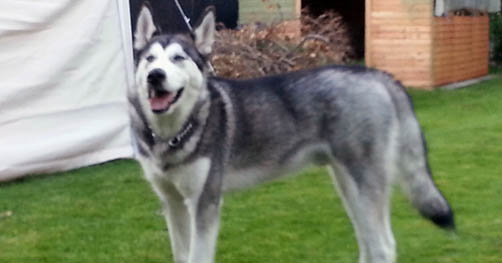
Marianne knows a thing or two about dogs and is very experienced with owning different breeds. But before she enrolled in my program she had trained her dogs using the traditional methods I mentioned above that are focused on punishments instead of rewards.
But Marianne was looking for a better way to train her dog to walk on a loose leash. She wanted her dog to pay attention to her, to walk at the same pace with her, and to respond to her body language.
Here’s an excerpt from a letter she wrote me after going through my Walk In Harmony Game Plan:
[order_box style=”4″ alignment=”center”]“Jean Cote’s Walk In Harmony Game Plan was certainly one of the BEST investments I have paid for – no classes, no fuel costs and no ‘waiting’ around to ‘do my turn’!
Jean Cote has changed my perspective on training and I am much more realistic in my expectations. Having had MANY dogs including Boxers, and bred Westies I thought I had done pretty well. Jean Cote has given me a much faster and patient methodology in training and with my latest (18 months at start of training) Chester – a Husky cross Alaskan Malamute, weighing now 6 stone+, it has been so rewarding for both of us in learning to ‘talk’ and ‘respond’ to each other – particularly as Chester is my ‘soul mate’ and just wants to ‘be’ with me and please me!”
[/order_box]I will be honest and say that her letter left me a little teary-eyed. There’s nothing better than making a difference in my students’ lives and seeing how much their relationships with their dogs blossom as a result of my training methods.
That is why I’m so passionate about this subject. It’s not just about training your dog to walk on a loose leash or to stop pulling. My ultimate goal is to give my students the tools and strategies to train their dogs to do anything they want them to do.
I believe the more time you spend interacting, training, and having fun with your dog, the less likely you are to give up your dog. There’s a crazy statistic from the ASPCA that 3.9 million dogs in the United States are abandoned to shelters every year. And of that number, 30 percent will be euthanized.
That is a staggering statistic, and it’s only for the United States. And so it’s my duty as a professional dog trainer to promote these training methods because I know how much they can improve the quality of life for both owners and their dogs.
I would like to thank you for reading this three-part series, and if you would like to continue your education I would be pleased to welcome you inside my “Walk In Harmony Game Plan.” I’m always excited to meet and greet new students, and I look forward to reading your success story.
Five Good Reasons You Should Train Your Dog to Walk on a Loose Leash
In the first article of this series, I shared my steps for training your dog to walk on a loose leash and stop pulling once and for all.
For some reason, whenever I discuss these training steps with my students, they always want more information. They want more details—almost like they’re looking for that secret piece of the puzzle that will magically transform their pets into perfect walking dogs.
However, the sad truth is that there’s no such thing. Nothing replaces hard work, and if you want a dog that walks on a loose leash, then you will have to take the time to train your dog.
I will admit that most people don’t find this proposition attractive. They think to themselves, You mean I have to train my dog? That’s way too much work!
Yes, that is exactly what I’m asking, but you don’t have to take any extra time out of your day. All you have to do is replace the time you’re already taking to walk your dog and replace it with the time you use to train your dog. Simple, right?
I wish all dog owners did this with their dogs. Unfortunately, even after I’ve laid out my logical case, most people still won’t take the time to train their dogs to walk on a loose leash. It requires effort, dedication, and energy.
So in this article, I’m going to share with you five good reasons you should train your dog to walk on a loose leash (and to stop pulling). These reasons are meant to energize and motivate you to take action and begin training your dog.
Reason 1—The longer you wait, the more your dog will pull on the leash.
It’s no secret that many dog owners will tolerate their dogs’ habit of pulling them. Many think it’s a normal part of owning a dog, whereas others simply don’t know what to do or how to solve the problem.
Either way, the longer a dog gets away with pulling on the leash, the harder it’s going to be to curb this habit, which is caused by self-rewarding behaviors—which is explained in detail in the first article of this series.
This is why training a puppy is so much easier than training a full-grown dog. A puppy has not yet developed the bad habits of walking ahead and pulling on the leash. You can get a puppy to walk nicely beside you in just a few training sessions.
Now, that’s not to say you can’t train an older dog who has been pulling for months or even years. You definitely can do it. However, it will be more challenging because you will need to replace the old habits of walking ahead and pulling with new ones such as walking by your side and paying attention to you.
Reason 2—Pulling is a serious safety issue.
Walking a dog that constantly pulls on the leash is not a pleasant experience, and in some cases, the dog pulls so hard that it causes physical pain in the owner’s hand, wrist, arm, or shoulder.
I recently had a student enroll in my Walk in Harmony Game Plan who had had an incident with her dog and needed surgery on her shoulder. She was walking her dog when, all of a sudden, her dog saw a squirrel and decided to run after it, putting massive strain on her shoulder.
Another student of mine suffered from a broken wrist because her dog was pulling on its leash during a winter snowstorm. She didn’t realize that her dog was pulling her toward an icy patch, and she ended up slipping and having to go to the hospital.
I even had another student tell me a story about when she almost got hit by a car because her dog decided to pull her toward a busy intersection. She was walking a big German shepherd, and had she not dropped to the ground to make her dog carry all of her weight, both she and her dog would have been hit by a car.
Now, these cases might seem extreme, but they are real stories from ordinary dog owners who never took the time to train their dogs to walk on a loose leash. They were just too busy with life, and their dogs’ tendency to pull them wasn’t a big enough problem.
My advice is to not wait until it’s too late before doing something about your dog’s pulling behavior. I know that prevention isn’t easy, but if it can prevent an injury, it’s time well spent, in my opinion.
Reason 3—Pulling on the leash often leads to less exercise.
Did you know that humans will do more to avoid pain than they will do to gain pleasure?
This simple fact is also at play for dog owners training their dogs to walk. For example, if your dog is constantly pulling and dragging you around the block, you will experience physical discomfort from a sore hand, wrist, arm, or shoulder.
On top of that, there’s also the emotional pain of what others will think of you. Often, people will make the assumption that you’re a bad dog owner simply because your dog is pulling you on the leash.
I had a student in my Walk in Harmony Game Plan tell me how her neighbor told her silly things as she walked her dog such as “You should have a sled,” “It’s a good thing you don’t have a big dog,” and “Your dog is sure leading the way!”
Of course, her neighbor was just trying to be funny and didn’t intend for those comments to be hurtful. But sometimes what others say can influence us more than we realize, and we can easily associate physical and emotional pain with walking our dogs, which leads us to unconsciously walk them for shorter distances and less frequently.
Another student of mine presents a perfect case of this. She was so ashamed of what other people thought of her while she walked her dog that she would only walk her dog late at night or early in the morning when it was still dark so that nobody could see her getting dragged down the road.
The overall problem is that dogs need lots of daily exercise to release their excess energy, and if you end up walking your dog for shorter distances and less frequently, it will be getting less exercise. If your dog doesn’t have an outlet for excess energy, it will find another way to get rid of it, even if that means doing destructive things such as barking, digging, and chewing.
My sister had this exact problem with her dog a few years ago. Her dog was constantly chewing shoes and furniture. All of that stopped when she started walking her dog for an hour twice per day—her dog simply wasn’t getting enough exercise.
Reason 4—Be able to go anywhere with your dog.
Wouldn’t it be great if you could go anywhere with your dog? This is why I’m so passionate about loose leash training. I want dog owners to be able to go to the park, attend public events, hike, jog, or even take a trip to their local pet store with their dogs. Why should anyone be restricted to just going around the block?
Not only are longer walks beneficial to your dog’s health and well-being, but they’re also great for getting rid of stress. So many of my students live hectic lives with busy schedules, and they tend to be exhausted when they come home at night. The problem is that walking their dogs becomes a chore rather than a way to relax and be out in nature with their dogs.
That’s why taking the time to train your dog to walk on a loose leash is so important. Once you’ve trained your dog, you can go wherever you want, whenever you want. Walks are no longer stressful situations.
Reason 5—Training transforms your dog into a happier, better-behaved family pet.
When I ask my students why they decided to get dogs, they usually tell me it’s because they thought getting a dog would bring happiness to their lives, that their dogs would cheer them up when they felt alone or sad, or that having a dog would give them a reason to get out of the house. But these reasons somehow get forgotten over time, and the struggles of owning a dog become the main focus.
I’ll admit that it’s important to address any behavioral problems that come up with your dog; however, it’s just as important to remember why you’re doing all of this in the first place. Focusing on the problem doesn’t solve it. Focusing on the solution does.
What will motivate you to seek the solution is the vision of why you wanted to get your dog in the first place: the moments you imagined sharing with your dog and the positive things you thought it would bring to your life. If you can get through the tough times, even when it seems like there’s no hope for you or your dog, your relationship will grow stronger. It’s kind of like a couple getting through a rough time. Maybe it’s someone getting laid off at work or a death in the family. It’s extremely difficult during those times; however, once they’ve passed, the couple can look back on them and smile because those events made them stronger.
The same is true with training your dog to walk on a loose leash. It may seem hopeless right now, but it can be the time when you learn how to properly train your dog by using positive reinforcement. If you take the time to master these training techniques now, you’ll not only get a dog that walks on a loose leash but also one that wants to please you in the future. Because the training methods I share in my Walk in Harmony Game Plan are widely applicable, you can use them to get your dog to do almost anything.
Many of my students continue to train their dogs beyond the scope of the program. They’ll use what they learned to teach their dogs to do tricks and all sorts of other neat stuff.
PART 3:
In the final part on this series on training your dog to walk on a loose leash, I’m going to share some real-life success stories of how my students used my Walk in Harmony Game Plan to get their dogs to walk on a loose leash and how you can do it too. Stay tuned.
The Ultimate Guide on How to Train Your Dog to Walk on a Loose Leash
Is your dog pulling you on the leash? If so, then you’ve come to the right place. In this training guide, I’m going to share with you four training steps to getting your dog to walk nicely on a loose leash with you and to stop pulling once and for all.
Now, before we dive into the actual training, I’d like you to meet Sophie.

This is a picture of Sophie on the very first day I met her. You see, I met Sophie because my friend was having an extremely difficult time walking her. She would pull on the leash, bite the leash, tug on the leash, lunge at anything that moved, jump up, and bite clothes and shoes.
Does any of this sound familiar?
Although your dog’s pulling behavior might not be as bad as Sophie’s was, I want to share with you exactly what I did to train Sophie. This way, you’ll get a real-life example of how my training methods can be applied and get some insight into how to use them with your own dog.
The sad truth is that there are many ways of training a dog. And though all training methods do work in their own ways, I’m what you could call a gentle soul and have a strong belief that inflicting physical pain on a dog during training is unacceptable.
That is my own personal belief, and it has forced me to think “outside the box,” so to speak, and train using a different method—with positive reinforcements (or force-free, as some would say).
Okay, let’s get started!
TRAINING STEP #1: Eliminate Self-Rewarding Behaviors
Before I give you training advice on what to do, it’s really important that you first understand WHY your dog is pulling on the leash in the first place.
Pulling on the leash is not a natural behavior that your dog is born with. Why would a dog want to strangle himself to the point of gasping for air?
The main reason a dog pulls on the leash is because it’s a reinforced behavior. Yep, in one way or another, your dog is being rewarded for pulling (I’ll explain how below), and most dog owners aren’t even aware of it.
Let me give you an example.
John decides to take his dog to the park for a game of fetch. He knows how much his dog loves this game, plus it’s good for his dog’s health and well-being. So they start walking, and his dog pulls and drags him all the way to the park. They then proceed to play fetch for ten minutes.
This might be a pretty obvious example, but the act of playing fetch (which is something his dog loves more than anything else) will reward any behavior that occurred before, including the pulling.
If you look at it from the dog’s point of view, why wouldn’t he pull? The faster he gets to the park, the faster he will be able to play fetch. And if his owner isn’t aware of what’s happening and how this is rewarding his dog for pulling, the behavior of pulling will get worse over time.
Imagine that this scenario is repeated daily for months. This is how pulling becomes a big problem, and if nothing is done, John will end up with a sore shoulder and wrist and begin to resent walking his dog.
Here’s how you can stop this downward spiral dead in its tracks:
Whenever your dog pulls on the leash, especially if your dog is trying to get to or at something, stop walking and wait for the leash to loosen. An even bigger deterrent is to turn around altogether and walk in the opposite direction.
What does this do? Remember, your dog is pulling to get to something more quickly, and stopping, walking, or turning around creates an incentive to keep the leash loose.
This is exactly what I did with Sophie (which you can see inside my Walk in Harmony Game Plan).
Sophie would pull because she wanted to go to the park and sniff the grass. She would pull when she wanted to meet another dog or stranger or whenever there was an object on the floor she wanted to sniff and investigate.
I had to teach her that pulling would delay the time before she could get to those things. And it worked!
You can do it too. All you have to do is commit to practicing this simple exercise with your dog for the next week or month. Now, before you go ahead and try this exercise, you first have to take into consideration how long your dog has been pulling.
If your dog has been pulling for months or even years, then it’s going to take considerably longer to undo this conditioning. Pulling is like a bad habit, and habits are hard to break. It simply takes time, dedication, and consistency.
TRAINING STEP #2: Reward the Behaviors You Want
The second biggest factor that will influence your dog’s walking behavior is whether you are rewarding your dog for walking nicely with you.
You would be surprised by how many dog owners I’ve worked with who don’t actively do this. And I don’t blame them; our society has programmed us to adopt a punishment mind-set. We are used to looking for ways to punish or suppress bad behaviors.
Here’s a personal example. In one of my relationships, my girlfriend really wanted me to call her every single night. If I missed just one phone call, however, she would become angry with me and let me have it the next time I called her. She wanted me to call more often, but her approach was to punish me for not calling, so when I did call, I received lots of pain.
What do you think ended up happening? You guessed it—the frequency of my phone calls lowered until one day our relationship ended.
Traffic tickets are another example. We all know that speeding is bad and we shouldn’t do it. But let’s be honest—the real reason we don’t speed is because we don’t want to get a speeding ticket. We don’t want the burden of dealing with a police officer and having to pay the fine. And a speeding ticket will usually drive up the cost of car insurance.
Most of us want to avoid the consequences of speeding.
But what if we flipped the psychology, and instead of punishing the “bad” behavior, we rewarded the “good” behaviors?
What if a cop pulled you over and handed you $50 for driving the speed limit? Would you be more or less likely to drive the speed limit in the future? My guess is that you would be more likely to do so.
Of course, this wouldn’t be practical because it would cost a fortune. Luckily, there aren’t any limits on the amount of positive reinforcement you can give your dog. You can easily reach down and give your dog a pat on the back while saying “good dog!” for walking nicely at your side.
And here’s the kicker: the more often you reward your dog, the more your dog will want to walk nicely with you. The behavior will grow over time.
This is exactly how casinos work. A casino never forces anyone to play a slot machine, but if you walk into any casino, you will find someone playing—and most likely losing money.
How do casinos do it?
It’s simple! The casino rewards the player for playing! Everyone who walks into a casino has the dream of walking out rich, of making an extra $10,000 or even $1,000,000. That rarely happens, though. What casinos do instead is give smaller rewards randomly.
Imagine you are on your tenth play and all of a sudden your slot machine starts making noise, the siren goes off, and your machine rack up points for two entire minutes. Everyone around you smiles and congratulates you on your big win. You’re now just a little bit ahead.
And what do you do? You guessed it—you keep on playing in hopes of getting an even bigger prize.
This is exactly how you want to think when training your dog. You want your rewards to build the behavior of walking nicely with you. And it’s extremely simple to do, as I show in my Walk in Harmony Game Plan.
First, you will need to make a list of the behaviors you want to reinforce. These might include walking at your side, looking up at you, stopping when you stop walking, keeping up the same pace as you, ignoring objects on the ground, ignoring other dogs, etc.
Then simply give your dog a reward for engaging in those behaviors. The reward can be anything: saying “good dog” in a cheerful and happy tone of voice, touching and patting your dog, stopping and playing a quick game of tug, or giving your dog a delicious treat.
The key is to give the reward immediately after the behavior so your dog makes the association between his behavior and the reward.
TRAINING STEP #3: Focus on Progress Instead of Perfection
I wish I could tell you that you can get your dog to stop pulling in one afternoon. It would make a great marketing sound bite. The reality, however, is that it’s probably going to take longer than that. It really depends on how long your dog has been pulling.
For example, a dog that has been pulling on the leash for five years has developed a habit that will be harder to break than the habit of a young puppy that is just learning the rules of walking.
But no matter how long your dog has been pulling, you can change the behavior. The key is to focus on progress instead of perfection.
What you want to do is to focus on improving your dog’s current behavior. If your dog can only walk four steps before pulling on the leash, your goal should be to get your dog to take five steps without pulling.
Your goal should be to ask “a little bit more” from your dog each time you go out for a walk.
This is how professional dog trainers train dogs: they focus on the next achievable step. And this is exactly what I did with Sophie. I didn’t show up one day and have one training session, and then she was magically transformed into a Lassie. It took many training sessions with a focus on improving her walking behavior a little bit each day.
In fact, I kept a written journal of every training session I had with her, and I would highly recommend that you do the same.
Here is what it looks like:

It’s very simple. All you have to do is write three things:
- What went well during the training session (or walk). I’m a firm believer in celebrating successes no matter how small they are. This acknowledgement is also going to give you the emotional juice to keep going.
- What didn’t go well during the training session (or walk). This will be really easy to remember, but I still urge you to write it down. Why? If you write it down, you won’t have to remember it. It’s like Einstein said: “Paper is to write things down that we need to remember. Our brains are used to think.”
- What you need to work on in the next training session (or walk). This is the most important thing to write down, so try to do it immediately after your training session (or walk). Doing so will make your brain think about a solution rather than dwelling on the problem.
And if you are a more advanced trainer, you may even want to videotape your training sessions. That way, you can review the footage and even ask for advice on possible training solutions. For the vast majority of dog owners, though, this isn’t practical or necessary.
All you need is a simple notebook to use as a training journal.
This is why my Walk in Harmony Game Plan is so effective: because I went through this process with Sophie and kept a written record of every one of my training sessions with her. I could open up my training journal right now and tell you exactly what I did during each training session.
TRAINING STEP #4: Play Training Games to Strengthen Skills
Did you know you can improve your dog’s walking behavior without ever leaving the house? Yep, all you have to do is work on teaching your dog the following five skills:
- Attention
- Self-control
- Obedience
- Loose leash manners
- Body awareness
What are these skills?
They are skills that you can teach inside your home where there are no distractions, and then once your dog has mastered them, you can utilize them outside to make walking your dog easier.
For example, you can teach your dog to look up at your face. How useful would this be? Well, next time you are walking past a distraction, you can say “look at me,” and your dog will look at you instead.
Or how about teaching your dog to control his instinct and not lunge or pull toward things on the ground? This is exactly what happens when you strengthen this skill.
So how does it work?
Simple. All you have to do is set aside ten to fifteen minutes a day and teach your dog a particular skill.
I lay out all of my skill-building training games in my Walk in Harmony Game Plan, but here is one I played with Sophie. The objective was to teach her to ignore a pile of popcorn on the ground.
(Click the play button below to watch the video.)
As you can see from the video above, Sophie was quite persistent in the beginning. By the end of the training session, however, she had much better self-control. Imagine if you worked on this every day for a week or a month how much better your dog would be!
PART 2:
In the second article of this series, I’m going to share five reasons why you should train your dog to walk on a loose leash (and to stop pulling) that are incredibly important. As a loving pet parent, you absolutely need to be aware of them. Click here to read part two.
Five Master Steps To Create A Dog Training Game Plan
In this post, I’m going to walk you through exactly what we do here at Success Dogs to create a dog training game plan to solve any dog training problem. This is the same process that I use to create our online dog training programs or when I work with a dog one-on-one.
Before we dive in, you might be wondering what a game plan is. A game plan is our term for an outlined strategy to solve a particular problem or to teach a dog a particular skill.
Think of a sport: Coaches have to come up with a winning strategy before they step a foot onto the field. They have to create a plan that they believe will bring them to victory.
We approach dog training the same way—with an end result in mind. Then we create a training plan that adheres to our guiding principles.
Let’s get started!
MASTER STEP 1: THE BIG PROBLEM

The first thing that you need to do is identify what the big problem is. And by big problem, I mean whatever you want to solve with your dog.
Maybe it’s peeing on the carpet, not coming when called, or pulling on the leash. Whatever it is, you have to be clear about solving one specific problem.
Oftentimes when a dog owner asks me to help train their dog, the owner will tell me how their dog has many problems and will want me to create a training plan to solve all of them. And I have to tell the owner that it’s better to focus on solving one problem at a time than to try tackling four or five problems and end up becoming overwhelmed and frustrated.
So right now, think about one specific problem with your dog, and dedicate the remainder of this guide to solving it.
To help you understand how I go about creating a training game plan, I will go through the process as if I’m working with a dog that pulls on the leash. I recently worked with a dog that had this problem, so it’s fresh in my mind.
YOUR ASSIGNMENT: Write down one problem with your dog that you are dedicated to solving.
MASTER STEP 2: YOUR INSPIRING VISION

Once you know exactly which problem you want to change, it’s time to move on to the next step, which is to create an inspiring vision.
This is what you want your dog to become, or how you would like it to be if your dog didn’t have the particular problem. Really think about this. The clearer you are about what it is that you want, the more likely you will be to attain it.
It’s not enough to go from “my dog is digging in the backyard” to “I want my dog to not dig in the backyard.” That isn’t going to motivate anybody, and to be totally honest with you, you’re going to need to take some action to solve your dog’s problem. There’s just no way around that.
You need to create an inspiring vision so you are pulled forward toward change rather than having to force yourself to take action.
I’ve been to dozens of self-help seminars, including all of Tony Robbins’ seminars, and what they all have in common is that you have to create in your mind a clear picture of what you want—something that emotionally inspires you.
So think about your vision and add emotion to it. How would you feel if your dog never had this problem again? How much stress would that eliminate? How much happier would you be? And how would your relationship with your dog grow as a result? Would you feel closer to your dog? Would you enjoy your dog’s company more?
Step into this vision and feel like it’s happening today. How do you feel?
ASSIGNMENT: Write down in your own words a vision of your dog that inspires you.
MASTER STEP 3: CLOSING THE GAP
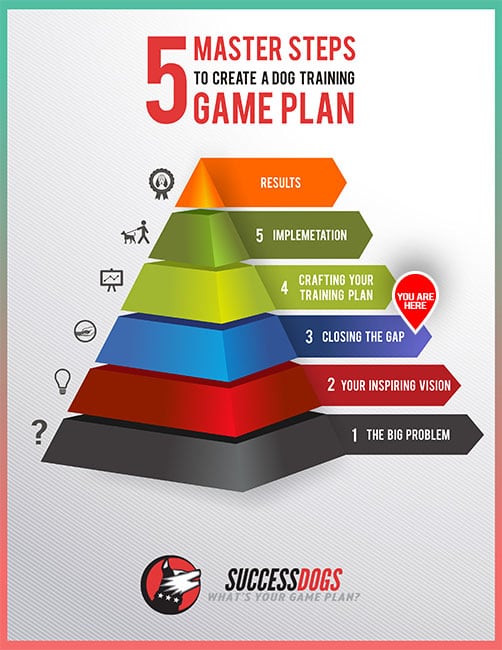
When you think about the problem you have with your dog and your inspiring vision, there’s an obvious gap between the two. This stage is about figuring out ways to close this gap.
First, let’s analyze the problem in a little bit more depth. The more you know about it, the easier it’s going to be to craft your training game plan.
Ask yourself the following three questions:
#1: When does this problem occur?
#2: What triggers the problem to occur?
#3: Is there more than one trigger?
Your answers to these questions will give you a great deal of clarity. For example, when I answered them for a dog that was pulling on the leash, I figured out that she would pull mainly when she wanted to get to something, whether that was a leaf blowing, grass on the ground, or an exciting smell coming from an object. She didn’t really “pull all the time,” as her owner described the behavior to me.
From those answers, you should be able to come up with a list of one or two focus areas that you need to work on with your dog.
For example, if the dog lunges at a blowing leaf, I need to develop the dog’s self-control skills—that’s one focus area. And if the dog strains at the end of the leash, I need to build that dog’s attention skills—that’s a second focus area.
You always want to think in terms of improving your dog’s particular skill or ability. This will keep you from falling into the punishment trap, in which you punish your dog for not doing what you want.
ASSIGNMENT: Write down one or two focus areas that you’ll commit to improving.
MASTER STEP 4: CRAFTING YOUR TRAINING PLAN
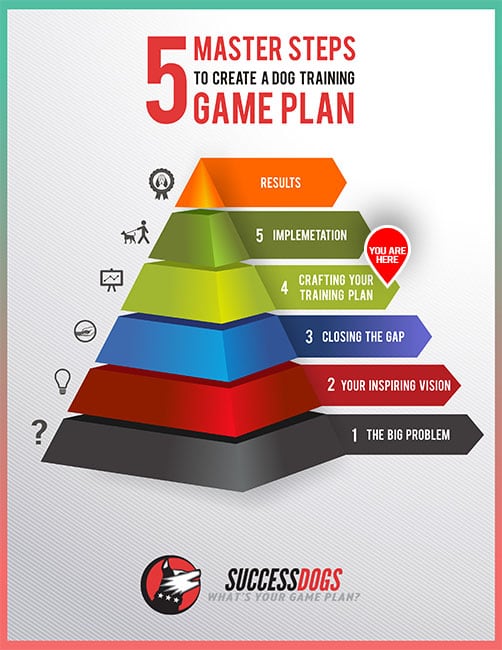
Do you see the magic in what we’ve done so far? Instead of having one giant and overwhelming problem that you’re trying to solve, you can instead focus solely on one or two areas. This completely changes the way that you’re going to go about training.
In this stage, the objective is to create action steps that you can implement with your dog on a daily basis. You’ll need to take each of your focus areas and brainstorm ways to improve them, while making sure that they are both achievable and incremental.
What I mean is that you must always set your dog up for success, and each step should build upon the previous one so that the focus area gradually improves.
To give you an example, here are my lists of action items for both areas of focus:
Self-Control:
- Ignore a dog treat in my hand (indoors)
- Ignore a dog treat on the floor (indoors)
- Ignore human food on the table (indoors)
- Ignore human food on the floor (indoors)
- Ignore a whole bag of popcorn on the floor (indoors)
- Ignore a rock on the ground (outside)
- Ignore a paper cup on the ground (outside)
- Ignore an opened bag of chips on the ground (outside)
- Ignore a leaf on the ground (outside)
- Ignore a blowing leaf on the ground (outside)
Attention:
- Touch my hand (indoors)
- Touch my hand at my side (indoors)
- Touch my hand while walking (indoors)
- Touch my hand while turning directions (indoors)
- Touch my hand while ignoring a dog treat on the floor (indoors)
- Touch my hand (outside)
- Touch my hand while walking (outside)
- Touch my hand while walking on the grass (outside)
- Touch my hand while ignoring a paper cup on the ground (outside)
- Touch my hand while ignoring a blowing leaf (outside)
As you can see, some of these action items from both focus areas overlap. And that’s okay, but can you see how the focus is on developing the skill rather than on stopping the problem?
ASSIGNMENT: Write at least ten action items for each focus area. Don’t try to make this perfect—just brainstorm, and you can always revise the list later.
MASTER STEP 5: IMPLEMENTATION

Once you’ve created your training plan, the only thing left to do is to implement it with your dog.
From my experience in training dogs, there’s nothing like the power of scheduling. I know that this isn’t attractive, but if you write down on your calendar which days you’re committed to training your dog and for how long, you’ll be much more likely to follow through.
I know that you’re busy. You work long hours, and you really don’t feel like training your dog after a long and busy day at work. I get it. But what if you only committed to implementing this training plan for a week, two weeks, or a month? That’s a very small fraction of your dog’s life and could make a huge difference.
Do you remember your inspiring vision? This is what’s going to motivate you to take action and take the time to train your dog.
How often and how long you should train your dog is totally dependent on what the problem is and how much time you have. I highly recommend keeping your training sessions short (about fifteen to twenty minutes)—shorter if you are working on an intricate behavior.
The minimum that you should train your dog is once a day. You won’t get the results that you want if you skip days or train your dog only once a week. And if you want even faster results, you can train several times per day, say in the morning, afternoon, and evening.
ASSIGNMENT: Schedule your next three training sessions with your dog. They can happen all during one day or be spread out over three days.
RESULTS

Once you implement the training plan with your dog, you will notice results. And if these results are not exactly what you’re looking for, that’s okay. You may have to change something in your training plan.
This is exactly what I do with every dog that I work with. First, I implement the training plan that I created. If the action item inside the training plan doesn’t work, I simply go back to the drawing board and make a change. I then try again, and do this over and over until I succeed.
This is the magic formula for dog training success.

CONCLUSION
This is the exact process that I use to train any dog, regardless of the problem. And now, you can use it with your own dog.
If you would like to see exactly how I worked with the dog that pulled on the leash, I recorded all of my training sessions and created a course called The Walk in Harmony Game Plan. Inside, you can see exactly which skills I developed and how, as well as all of the different action items that I implemented to get what her owner wanted, a dog that walked nicely on a loose leash.
Training Concept: The Four Stages Of Luring
In this post, I’m going to discuss in great depth the four stages of luring, a common training technique to get your dog to do a specific behavior such as sitting, lying down, or rolling over.
Luring is extremely easy and will work with any dog that is food motivated. You place a piece of food inside your hand and position it next to your dog’s nose. Because your dog will want the food, it will begin to sniff your hand. While your dog is interested in the food, you can move your hand in different positions to prompt your dog to get into a certain position.
For example, you can move your hand upward and toward your dog’s ears to get it to sit or move your hand down and toward its paws to get your dog to lie down. It’s a useful technique available to anyone wanting to train a dog by using positive reinforcements.
However, it does have its limits. You cannot use luring to counter-condition an existing behavior such as barking or pulling on the leash. And you cannot use it to teach your dog an intricate behavior such as playing chess or retrieving a ball.
Luring is the first technique I learned to train my dog with. I learned it while attending dog training classes here locally. And I will never forget the moment when I was finally able to communicate what I wanted to my dog. So that my dog learned to instantly respond to my “sit,” “down,” “stand,” and “get in” commands.
In fact, here is a short video of those four behaviors taught using this technique:
THE DIAGRAM:
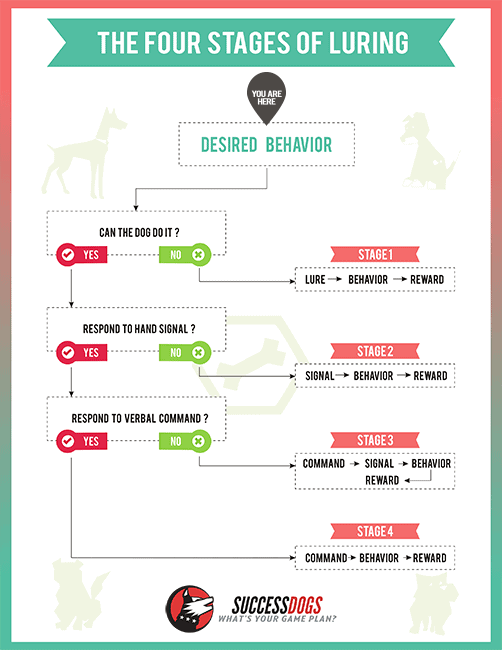
I created this diagram to help you understand more clearly luring process and how you can get to the point where your dog responds to your verbal commands.
The first step, as indicated by the “YOU ARE HERE” marker in the image above, is the behavior you want your dog to do.
Whenever you use this diagram, you must think about one specific behavior you want to train. This is what I call the “desired behavior.” Then you go through the questions on the left, and if any of the answers is “no,” then this is the stage you need to work on.
I will explain each stage in detail below.
STAGE 1:

Once you’ve figured out exactly which behavior you want to work on, then you must ask yourself the first question: “Can the dog do it?” This question is in relation to your ability to lure the dog into that position. For example, if your desired behavior is getting your dog to sit, well, every dog is able to sit at some point. But can your dog do it in relation to the lure? The question really should be, “Am I able to consistently lure my dog into this position?” but it didn’t fit inside the diagram.
So if the answer is “no,” then this is where you need to begin.
You will need to pick a food that your dog absolutely loves, something that it only gets as a treat, like a piece of chicken or sausage. Then place this food inside the palm of your hand and close your hand like a fist. Your dog will be able to smell the treat but won’t be able to eat it.
And the way this stage works is this: You move your hand while your dog is sniffing it. This is essentially what luring is. Because your dog is trying to get to the food, it will follow your hand. Your goal here is to move your hand in a way that gets your dog in a particular position.
So, for example, if you wanted to get your dog to sit, you would move your hand upward and toward your dog’s ears.
Now, the secret for this to work with your dog is all about when you release the treat. This is what is going to communicate to your dog: Whatever behavior you just did is what earned you this treat.
So to reward the sit, you would immediately open your hand and give your dog the treat after its behind touches the ground. And when you do this over and over, your dog will quickly learn that the fastest way to get the treat is to sit down.
There is also the option of giving a marker signal once your dog gets into the desired position. A marker signal can be either the word “yes” or the sound of a clicker. In this stage, a marker signal is not needed because releasing the treat once the dog gets into the desired position is enough for a dog to understand what you want.
STAGE 2:
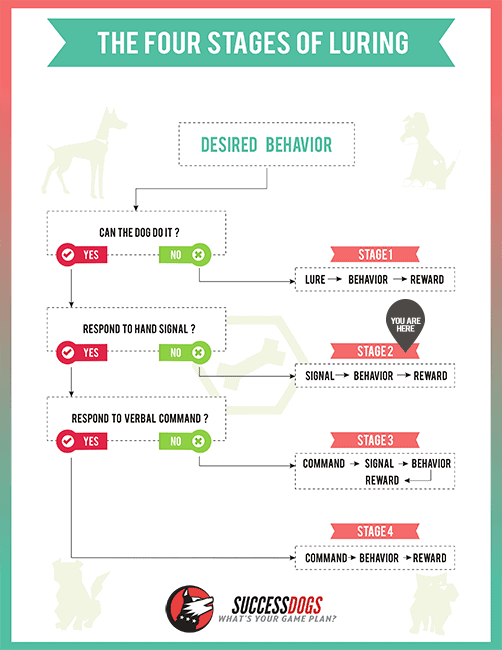
Okay, it’s time for the second stage. This is where you teach your dog to respond to a hand signal. You need to teach your dog a unique hand signal for every specific behavior. For example, sitting is an upward motion with the palm of your hand facing upward.
Teaching your dog a hand signal has numerous benefits, the main one being preventing your dog from becoming dependent on you having a treat in your hand for it to do the behavior. Another reason is that you want your dog to learn your body language so you can communicate at a distance.
I remember when I taught my dog Onyx to respond to all of my hand signals for the obedience behaviors. She would lie down, sit, stand, come, and sit at my side without me ever having to say anything. I thought it was the coolest thing ever.
And this is why I love this stage so much: You are effectively communicating with your dog with just the use of your body. Dogs are extremely visual, and they can notice the slightest change in your physiology.
To teach your dog a hand signal, you will have to do it gradually because if your dog is used to following a lure, and all of sudden you use a hand signal, your dog is not going to understand.
That’s why you must first create a pattern so your dog will be successful. This is done by luring your dog three times in a row (the same way as described in stage one). Then, on the fourth repetition, take the food out of your hand and move your hand the same way as a lure.
This works well because you’ve just rewarded your dog three times in a row for getting into the position. And your dog is smart; it will anticipate that you want the behavior repeated. So even though there isn’t any food in your hand, your dog is still going to do the same thing.
This is what is called a 3:1 ratio; you lure your dog three times in a row, each time followed by a hand signal. Then continue practicing until you can lower the ratio to 2:1, then 1:1 and, eventually, you phase out the lures altogether.
What is important to note here is that this is a gradual process; it won’t happen overnight. You need to make sure your dog is successful. If you try to give your dog a hand signal over and over, and the dog fails, you’re both going to become frustrated. That’s why you have to take it one step at a time.
From my years of experience teaching hand signals, I would like to share one more key distinction with you. Whenever you give your dog a hand signal, and it responds by doing the behavior you want, you should always bring your treat to your signal hand before giving it to your dog. This will keep your dog focused and attentive to your signal hand because that is where the treats are.
Once your dog consistently responds to your hand signal and is no longer dependent on the lures, you will want to move on to the next phase, which is to refine your hand signal.
For example, a hand signal in the beginning might look more like a lure with the hand closed and close to the dog’s nose. But then you will want to make refinements to that hand signal and open your palm and face it in a certain direction.
What you want to do is make one small change at a time. Once your dog is successful, continue refining your hand signal. You can continue doing this until you have the perfect hand signal you want. It’s totally up to you.
You will also need to do the same thing with distance. Begin with a hand signal next to your dog’s nose and gradually increase the distance until you are a foot or two away.
STAGE 3:
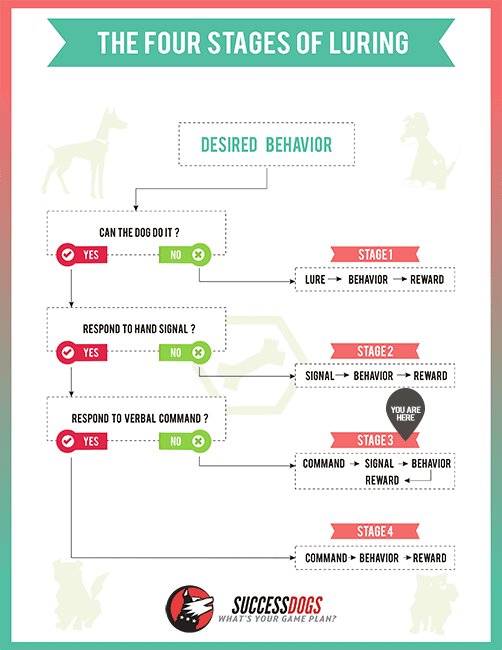
This might surprise you, but did you notice that I didn’t mention anything about a verbal command in the first two stages?
The reason is that dogs have no idea what a verbal command means until it’s been associated with a certain behavior. In fact, dogs don’t understand the commands “Sit” or “Down.” You could train your dog to sit when you say “Banana” if you wanted to. The word itself is meaningless.
The way dogs learn a verbal command is through repetitions in which the dog learns to offer a specific behavior after hearing the command in order to get the reward. It’s that simple.
And I have some great news. Most of the hard work is done in the first two stages in which you teach the dog the behavior and the hand signal. Once you can consistently and easily signal your dog into a position, then all you have to do is say your verbal command just before giving your hand signal.
Here is an example: In stage two, you would begin by giving your dog the signal for sitting. Then your dog would sit. And then you would give it a treat.
Now all you have to do is say “Sit.” Then give your hand signal and, once your dog sits, you give it a treat. Your dog will learn through repetition that every single time you give your verbal command, the same hand signal is given afterward. Eventually, your dog is going to start doing the behavior before you even have a chance to give your hand signal.
Simple, right?
There are a few important details that I would like to bring to your attention. First, make sure that you say your verbal command without using any body language. This means that, before you say your verbal command, make sure that you stand tall with your arms and hands at your side.
Most dogs are primarily visual, and they will pick up on any subtle body language, so if you nod your head every time you give the command “Down,” your dog might be responding to the nod rather than the verbal command.
Second, you must always say your verbal command before giving your hand signal. It won’t work if you say it at the same time, and this is a common mistake new trainers make.
Third, and this is a little more advanced, but my guess is you want to master this training method, or you wouldn’t have read this far. You will want to randomize your repetitions. And what I mean by “randomize” is this: Instead of doing the same thing over and over at the exact same pace, try to increase and decrease the length of time between repetitions.
For example, you could do one repetition, then move around a little bit to distract your dog, then do another repetition. This randomization will keep your dog attentive to the initial trigger, which is your verbal command.
STAGE 4:
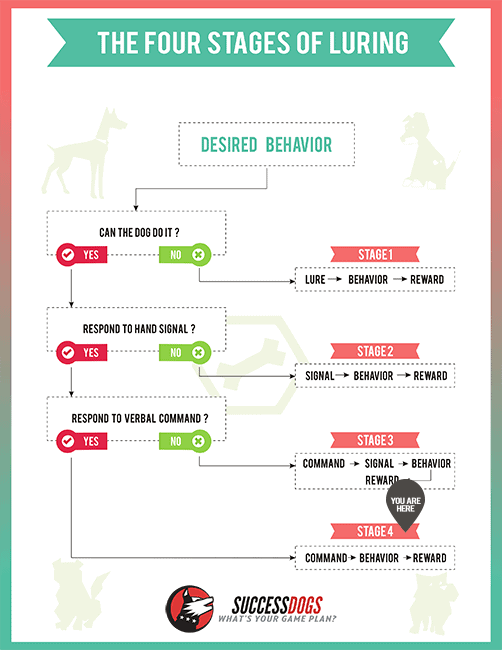
The final stage is all about phasing out your hand signal. You can continue working with the hand signal if it’s something you want to use with your dog, but my bet is you want your dog to respond solely to your verbal command.
Before you can begin phasing out the hand signal, it’s important that you’ve practiced the stage three exercise enough times that your dog is starting to perform the behavior before you have a chance to give your hand signal. This is what tells you when your dog is ready.
Do you remember how we created a pattern in stage two when we started with a 3:1 ratio: three lures to one hand signal?
You’re going to use this same principle in this stage to phase out the hand signal. The purpose, if you recall, is to create a pattern so your dog will be successful. If your dog does something three times in a row, the dog will most likely do it a fourth time.
So begin by creating a pattern with a 3:1 ratio. Practice giving your command three times in a row, followed by a hand signal, and then reward your dog for doing the behavior.
But on the fourth repetition, you will want to give your verbal command without giving a hand signal. Then wait: If your dog performs the behavior, make sure you celebrate; give your dog a treat and lots of praise. Your dog has effectively responded to your verbal command.
But this doesn’t always work on the first try. Sometimes you might need to give a slight hint of the hand signal, such as slightly moving your shoulder or arm. But the goal is to get your dog to respond solely to your verbal command. So be sure this doesn’t become a habit.
Once you are successful with a 3:1 ratio, the only thing left is to gradually reduce this ratio to 2:1, 1:1, and eventually phase out the hand signals altogether.
CONCLUSION:
I understand this might seem overwhelming, especially if you’re just starting out. It’s like learning how to drive a car. If you remember, it was hard, and you had to pay attention to so many things, but now you can do it without even thinking about it.
The same is true with this training method. Once you’ve gone through all four stages with your dog, you’ll say to yourself, “Ah, that was easy!” And it is, but you have to start somewhere.
So choose a behavior you’d like to teach your dog—something simple such as sitting. Begin with stage one, and work your way from there. If you would like to see specific examples, such as how to lure your dog into a sit position or what my hand signal looks like, you are welcome to get my Good Dog Every Day Program that demonstrates how I work with my own dog.
I look forward to hearing about your success with this training method.

